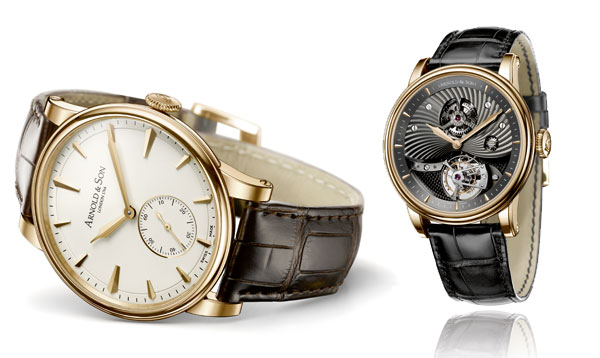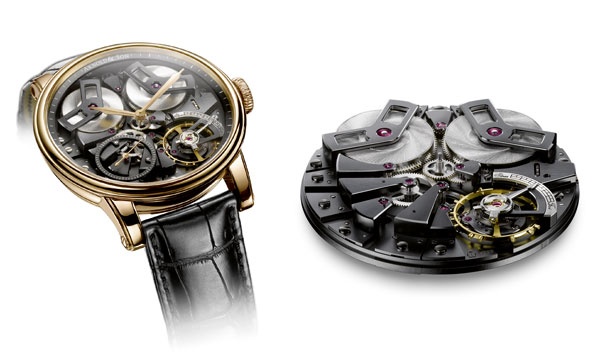
Arnold & Son HMS1
Case : rose gold, steel, crown at 3 o’clock, sapphire crystal. Diameter : 30mm. Movement : mechanical hand-wound (Calibre A&S1001 with 80-hour power reserve), 21,600 vibrations per hour, guilloché Côtes de Genève motif.Functions : hours, minutes, small seconds at 6 o’clock. Dial: white or black for the rose gold model, white or anthracite for the steel model. Water resistance : 30m. Strap : black or chestnut brown alligator leather.
Arnold & Son Tourbillon ‘TE8’
Case : 4N rose gold, crown at 3 o’clock, sapphire crystal. Diameter : 44 mm. Movement : mechanical hand-wound (Calibre A&S8000 with 80-hour power reserve), 21,600 vibrations per hour, 4N rose gold or grey ruthenium. ¾ wave-shaped barrel bridge, triangular-shaped tourbillon and motion-work bridges, wheels with three flared spokes. Functions : hours, minutes, tourbillon. Dial : 4N rose gold or grey ruthenium. Water resistance : 30m. Strap : black or chestnut brown alligator leather.
These are exactly the kind of timepieces that watchmaking connoisseurs follow with interest. Pure designs, noble materials and movements to match : the HMS1 bears the genetic imprint of the ultimate classic watch. It is pervaded by an aura of timeless elegance, and in an era when fashion calls for audacity, it manages to combine this quality with fine watchmaking. The abbreviation HMS evokes the names of British Navy warships, but also the field of watchmaking, where HMS stands for Hours, Minutes and Seconds. As a nod to its past on the other side of the Channel, Arnold & Son has therefore named this model HMS1. Knowledgeable connoisseurs agree that its charisma generates a blend of passion and fascination. Equipped with twin barrels ensuring an 80-hour power reserve, the watch definitely stands out in its field. It unites a set of powerful characteristics combining traditional and high-tech elements. Its perfectly round case houses a finely crafted mechanical ahnd-wound movement, Calibre A&S1001. It pays eloquent tribute to excellence and salutes the history of Arnold & Son. The brand has consistently expressed its know-how through original collections in which each watch radiates a distinctively harmonious nature. The founder’s creative spirit continues to shine through the HMS1 watch with its pure design and classic complication placing it in direct line from the noble legacy of John Arnold.
Therein lies the true secret of the Tourbillon ‘TE8’ watch, in its role of launching the new Arnold & Son collection combining fine horological classicism with contemporary technical innovations. Watches help to ritualise our daily lives, and Arnold & Son manages to reinvent a sense of pleasurable moments while paying homage to the finest complications, including the tourbillon. The new Arnold & Son Tourbillon ‘TE8’ watch is typical of the grand English tradition with its wave-shaped barrel bridge, triangular-shaped motionwork and tourbillon bridges, and flared three-spoke wheels. This three-spoke design can also be found on the tourbillon carriage. The beautifully chased wave-shaped decoration is a nod to the maritime world and pays tribute to all the great historical seamen and explorers, such as James Cook, George Vancouver and Johan Von Krusenstern, who chose to place their trust in timepieces by John Arnold. Compared to the classic tourbillon moments used today, that of the ‘TE8’ is of the “reversed” type, thus rendering the technically and visually interesting elements visible from the dial side. This timepiece that will appeal to devotees of fine English watchmaking boasts other technical features, including the particular attention that has been lavished on the symmetry of the movement and which entails a number of technical constraints. The barrel and tourbillon carriage have been aligned along a 12 – 6 o’clock axis, while the winding system is characterised by an historical construction using wolf’s tooth gear trains and thereby improving the precision and smoothness of the movement operation. All the finishing (such as specular polishing, drawn file strokes, circular satin brushing, bevelling and satin brushing) of this exceptional model are performed by hand by the Arnold & Son master-watchmakers, giving special radiance and depth to each decorative element. This exclusive timepiece is produced in 25-piece limited series for each variation, all numbered and engraved with the name Arnold & Son. It provides vivid proof that the peak of perfection may be enshrined within a tiny case.



